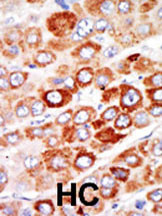AK1 Antibody (C-term)
Purified Rabbit Polyclonal Antibody (Pab)
- SPECIFICATION
- CITATIONS
- PROTOCOLS
- BACKGROUND

Application
| IHC-P, WB, E |
|---|---|
| Primary Accession | P00568 |
| Reactivity | Human, Hamster |
| Host | Rabbit |
| Clonality | Polyclonal |
| Isotype | Rabbit IgG |
| Calculated MW | 21635 Da |
| Antigen Region | 165-194 aa |
| Gene ID | 203 |
|---|---|
| Other Names | Adenylate kinase isoenzyme 1 {ECO:0000255|HAMAP-Rule:MF_03171}, AK 1 {ECO:0000255|HAMAP-Rule:MF_03171}, 2743 {ECO:0000255|HAMAP-Rule:MF_03171}, 2746 {ECO:0000255|HAMAP-Rule:MF_03171}, ATP-AMP transphosphorylase 1 {ECO:0000255|HAMAP-Rule:MF_03171}, ATP:AMP phosphotransferase {ECO:0000255|HAMAP-Rule:MF_03171}, Adenylate monophosphate kinase {ECO:0000255|HAMAP-Rule:MF_03171}, Myokinase {ECO:0000255|HAMAP-Rule:MF_03171}, AK1 {ECO:0000255|HAMAP-Rule:MF_03171} |
| Target/Specificity | This AK1 antibody is generated from rabbits immunized with a KLH conjugated synthetic peptide between 165-194 amino acids from the C-terminal region of human AK1. |
| Dilution | IHC-P~~1:50~100 WB~~1:1000 E~~Use at an assay dependent concentration. |
| Format | Purified polyclonal antibody supplied in PBS with 0.09% (W/V) sodium azide. This antibody is prepared by Saturated Ammonium Sulfate (SAS) precipitation followed by dialysis against PBS. |
| Storage | Maintain refrigerated at 2-8°C for up to 2 weeks. For long term storage store at -20°C in small aliquots to prevent freeze-thaw cycles. |
| Precautions | AK1 Antibody (C-term) is for research use only and not for use in diagnostic or therapeutic procedures. |
| Name | AK1 {ECO:0000255|HAMAP-Rule:MF_03171, ECO:0000312|HGNC:HGNC:361} |
|---|---|
| Function | Catalyzes the reversible transfer of the terminal phosphate group between ATP and AMP. Also displays broad nucleoside diphosphate kinase activity. Plays an important role in cellular energy homeostasis and in adenine nucleotide metabolism (By similarity) (PubMed:21080915, PubMed:23416111, PubMed:2542324). Also catalyzes at a very low rate the synthesis of thiamine triphosphate (ThTP) from thiamine diphosphate (ThDP) and ADP (By similarity). |
| Cellular Location | Cytoplasm {ECO:0000250|UniProtKB:P05081}. |

Thousands of laboratories across the world have published research that depended on the performance of antibodies from Abcepta to advance their research. Check out links to articles that cite our products in major peer-reviewed journals, organized by research category.
info@abcepta.com, and receive a free "I Love Antibodies" mug.
Provided below are standard protocols that you may find useful for product applications.
Background
Adenylate kinase is an enzyme involved in regulating the adenine nucleotide composition within a cell by catalyzing the reversible transfer of phosphate group among adinine nucleotides. Three isozymes of adenylate kinase have been identified in vertebrates, adenylate isozyme 1 (AK1), 2 (AK2) and 3 (AK3). AK1 is found in the cytosol of skeletal muscle, brain and erythrocytes, whereas AK2 and AK3 are found in the mitochondria of other tissues including liver and heart. AK1 was identified because of its association with a rare genetic disorder causing nonspherocytic hemolytic anemia where a mutation in the AK1 gene was found to reduce the catalytic activity of the enzyme.
References
Corrons, J.L., et al., Blood 102(1):353-356 (2003).
Toren, A., et al., Br. J. Haematol. 87(2):376-380 (1994).
Zuffardi, O., et al., Hum. Genet. 82(1):17-19 (1989).
Matsuura, S., et al., J. Biol. Chem. 264(17):10148-10155 (1989).
Miwa, S., et al., Am. J. Hematol. 14(4):325-333 (1983).
If you have used an Abcepta product and would like to share how it has performed, please click on the "Submit Review" button and provide the requested information. Our staff will examine and post your review and contact you if needed.
If you have any additional inquiries please email technical services at tech@abcepta.com.













 Foundational characteristics of cancer include proliferation, angiogenesis, migration, evasion of apoptosis, and cellular immortality. Find key markers for these cellular processes and antibodies to detect them.
Foundational characteristics of cancer include proliferation, angiogenesis, migration, evasion of apoptosis, and cellular immortality. Find key markers for these cellular processes and antibodies to detect them. The SUMOplot™ Analysis Program predicts and scores sumoylation sites in your protein. SUMOylation is a post-translational modification involved in various cellular processes, such as nuclear-cytosolic transport, transcriptional regulation, apoptosis, protein stability, response to stress, and progression through the cell cycle.
The SUMOplot™ Analysis Program predicts and scores sumoylation sites in your protein. SUMOylation is a post-translational modification involved in various cellular processes, such as nuclear-cytosolic transport, transcriptional regulation, apoptosis, protein stability, response to stress, and progression through the cell cycle. The Autophagy Receptor Motif Plotter predicts and scores autophagy receptor binding sites in your protein. Identifying proteins connected to this pathway is critical to understanding the role of autophagy in physiological as well as pathological processes such as development, differentiation, neurodegenerative diseases, stress, infection, and cancer.
The Autophagy Receptor Motif Plotter predicts and scores autophagy receptor binding sites in your protein. Identifying proteins connected to this pathway is critical to understanding the role of autophagy in physiological as well as pathological processes such as development, differentiation, neurodegenerative diseases, stress, infection, and cancer.



